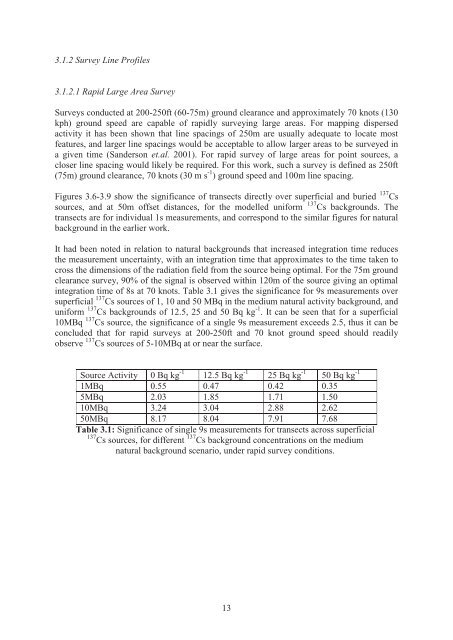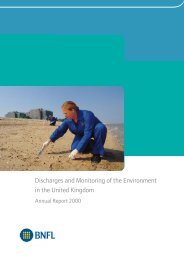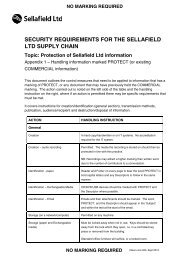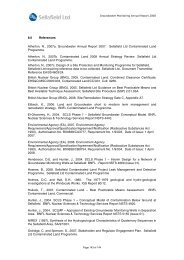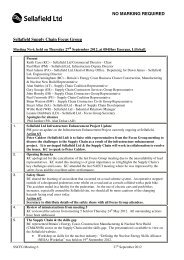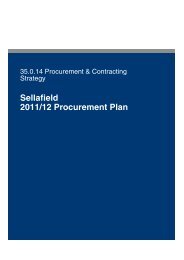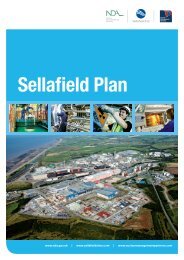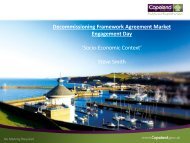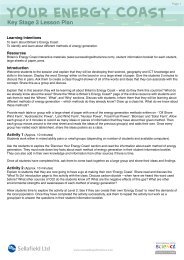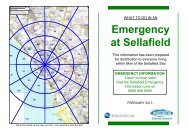- Page 1 and 2:
Particles in the EnvironmentAnnual
- Page 3 and 4:
SSEM/2011/4730 June 2011ContentsPur
- Page 5 and 6:
SSEM/2011/4730 June 2011List of Tab
- Page 7 and 8:
SSEM/2011/4730 June 20111. Introduc
- Page 9 and 10:
SSEM/2011/4730 June 2011Figure 2.1.
- Page 11 and 12:
SSEM/2011/4730 June 2011In August 2
- Page 13 and 14:
SSEM/2011/4730 June 20112.3.4 Find
- Page 15 and 16:
SSEM/2011/4730 June 2011as well as
- Page 17 and 18:
SSEM/2011/4730 June 2011The monitor
- Page 19 and 20:
SSEM/2011/4730 June 2011(Field Inst
- Page 21 and 22:
SSEM/2011/4730 June 2011Figure 3.2.
- Page 23 and 24:
SSEM/2011/4730 June 2011Figure 3.4.
- Page 25 and 26:
SSEM/2011/4730 June 2011number of f
- Page 27 and 28:
SSEM/2011/4730 June 20114.5004.000F
- Page 29 and 30:
SSEM/2011/4730 June 2011Table 3.5.
- Page 31 and 32:
SSEM/2011/4730 June 2011Figure 3.9.
- Page 33 and 34:
SSEM/2011/4730 June 20113.1.5 Risks
- Page 35 and 36:
SSEM/2011/4730 June 2011presence of
- Page 37 and 38:
SSEM/2011/4730 June 2011Beta-rich A
- Page 39 and 40:
SSEM/2011/4730 June 2011Find Popula
- Page 41 and 42:
SSEM/2011/4730 June 2011Log Am241 A
- Page 43 and 44:
SSEM/2011/4730 June 2011Beach Find
- Page 45 and 46:
SSEM/2011/4730 June 2011Log Pu239 A
- Page 47 and 48:
SSEM/2011/4730 June 2011Figure 3.22
- Page 49 and 50:
SSEM/2011/4730 June 2011Table 3.9.
- Page 51 and 52:
2.52.72.93.13.33.53.73.94.14.34.54.
- Page 53 and 54:
SSEM/2011/4730 June 2011In summary,
- Page 55 and 56:
SSEM/2011/4730 June 2011particles h
- Page 57 and 58:
SSEM/2011/4730 June 2011• Boron,
- Page 59 and 60:
SSEM/2011/4730 June 2011Table 3.15.
- Page 61 and 62:
SSEM/2011/4730 June 2011Recommendat
- Page 63 and 64:
SSEM/2011/4730 June 2011Recommendat
- Page 65 and 66:
SSEM/2011/4730 June 2011homogeneous
- Page 67 and 68:
SSEM/2011/4730 June 2011[the Sellaf
- Page 69 and 70:
SSEM/2011/4730 June 2011Figure 3.33
- Page 71 and 72:
SSEM/2011/4730 June 2011 © Nuclea
- Page 73 and 74:
SSEM/2011/4730 June 2011 © Nucle
- Page 75 and 76:
SSEM/2011/4730 June 2011The finding
- Page 77 and 78:
SSEM/2011/4730 June 2011Communicati
- Page 79 and 80:
SSEM/2011/4730 June 20115. Health R
- Page 81 and 82:
SSEM/2011/4730 June 2011The numbers
- Page 83 and 84:
SSEM/2011/4730 June 2011wear gloves
- Page 85 and 86:
SSEM/2011/4730 June 20116. Aims and
- Page 87 and 88:
SSEM/2011/4730 June 2011specificati
- Page 89 and 90:
SSEM/2011/4730 June 20116.5 Primary
- Page 91 and 92:
SSEM/2011/4730 June 20113. Where ar
- Page 93 and 94:
SSEM/2011/4730 June 20115. What is
- Page 95 and 96:
SSEM/2011/4730 June 2011Fundamental
- Page 97 and 98:
SSEM/2011/4730 June 2011size and wi
- Page 99 and 100:
SSEM/2011/4730 June 201130 May Drig
- Page 101 and 102:
SSEM/2011/4730 June 2011Figure 7.2.
- Page 103 and 104:
SSEM/2011/4730 June 2011Figure 7.4.
- Page 105 and 106:
SSEM/2011/4730 June 20117.2 Applica
- Page 107 and 108:
SSEM/2011/4730 June 20117.2.3 Consi
- Page 109 and 110:
SSEM/2011/4730 June 20117.3.2 DSRL
- Page 111 and 112:
SSEM/2011/4730 June 2011contract mo
- Page 113 and 114:
SSEM/2011/4730 June 2011Figure 7.7.
- Page 115 and 116:
SSEM/2011/4730 June 2011From 2008/0
- Page 117 and 118:
ID WBS Task Name Duration Start Fin
- Page 119 and 120:
ID WBS Task Name Duration Start Fin
- Page 121 and 122:
ID WBS Task Name Duration Start Fin
- Page 123 and 124:
SSEM/2011/4730 June 2011Hackney PD,
- Page 125 and 126:
SSEM/2011/4730 June 2011Appendix 12
- Page 127 and 128:
Harrington monitoring extent and as
- Page 129 and 130:
Whitehaven North/Harbour monitoring
- Page 131 and 132:
Nethertown monitoring extent for 20
- Page 133 and 134:
Drigg monitoring extent and associa
- Page 135 and 136:
This page is intentionally blank
- Page 137 and 138:
Contents1. Introduction ...........
- Page 139 and 140:
Figure 1 - Swath bathymetry of Scro
- Page 141 and 142:
Figures 4 to 6 show the same data w
- Page 143 and 144:
3.2 Options for acquiring new bathy
- Page 145 and 146:
3.3 Interpretation of gross geomorp
- Page 147 and 148:
Head, shows a marked northerly sedi
- Page 149 and 150:
of artefacts affecting the original
- Page 151 and 152:
This page is intentionally blank
- Page 154:
-
- Page 157 and 158:
Executive Summary
- Page 159 and 160:
Table of contents1 Introduction ...
- Page 161 and 162:
-
- Page 163 and 164:
sinks and transport pathways of rad
- Page 165 and 166:
-
- Page 167 and 168:
m thick ‘bins’ s
- Page 169 and 170:
-
- Page 171 and 172:
-
- Page 173 and 174:
-
- Page 175 and 176:
-
- Page 177 and 178:
‘direction to’, and the convent
- Page 179 and 180:
-
- Page 181 and 182:
-
- Page 183 and 184:
-
- Page 185 and 186:
-
- Page 187 and 188:
-
- Page 189 and 190:
-
- Page 191 and 192:
-
- Page 193 and 194: -
- Page 195 and 196: - - --
- Page 197 and 198: -
- Page 199 and 200: -
- Page 201 and 202: -
- Page 203 and 204: Bed shear stress exceedance - Sella
- Page 205 and 206: -
- Page 207 and 208: -
- Page 209 and 210: -
- Page 211 and 212: - -
- Page 213 and 214: Soulsby, R.L. and Whitehouse, R.J.S
- Page 215 and 216: -
- Page 217 and 218: -
- Page 219 and 220: -
- Page 221 and 222: -
- Page 223 and 224: About usCefas is a multi-disciplina
- Page 225 and 226: This page is intentionally blank
- Page 227 and 228: SummaryThe response of large volume
- Page 229 and 230: Contents1. INTRODUCTION ...........
- Page 231 and 232: Figure 3.15: 137 Cs activity concen
- Page 233 and 234: 2. MODEL PARAMETERISATIONThe approa
- Page 235 and 236: Figure 2.2: Stripped 137 Cs count r
- Page 237 and 238: 200150Number of finds1005000 5 10 1
- Page 239 and 240: 1000 Bq kg -1SignificanceSignifican
- Page 241 and 242: SignificanceSignificanceSignificanc
- Page 243: 0 Bq kg -1SignificanceSignificanceS
- Page 247 and 248: 40 Bq kg -13Significance21012.5 Bq
- Page 249 and 250: 3.1.2.2 Detailed Small Area SurveyF
- Page 251 and 252: 40 Bq kg -13Significance21012.5 Bq
- Page 253 and 254: 3.2 Patches of Enhanced 137 Cs acti
- Page 255 and 256: 3020Stripped cps100-100 200 400 600
- Page 257 and 258: Figure 3.15: 137 Cs activity concen
- Page 259 and 260: Figure 3.17: 137 Cs activity concen
- Page 261 and 262: 4. DISCUSSIONThe work reported here
- Page 263 and 264: distribution. There appears to be n
- Page 265 and 266: clearance reduce detection limits,
- Page 267 and 268: Appendix A: Location and Activity D
- Page 269 and 270: Position (BNG)Activity of recovered
- Page 271 and 272: 11/09/2007 301521 503408 6 Sand 195
- Page 273 and 274: 14/11/2007 301442 503457 4 Sand 255
- Page 275 and 276: 10/01/2008 301694 503522 12 Sand 27
- Page 277 and 278: 24/06/2008 301662 503500 4 Sand 263
- Page 279 and 280: 27/10/2008 302058 503065 5 Sand 128
- Page 281 and 282: 16/01/2009 301522 503320 7 Sand 367
- Page 283 and 284: 22/09/2009 301787 503592 7 Pebbles
- Page 285 and 286: 17/03/2010 301446 503542 2 Sand 26
- Page 287 and 288: 31/08/2010 300219 505597 0 Sand 33
- Page 289 and 290: Position (BNG)Activity of recovered
- Page 291 and 292: 24/05/2010 299805 505799 3 Sand 30
- Page 293 and 294: Position (BNG)Activity of recovered
- Page 295 and 296:
Activity of recoveredPosition (BNG)
- Page 297 and 298:
This page is intentionally blank
- Page 299 and 300:
Page 2 of 3provides useful informat
- Page 301 and 302:
Week StartingSoftrak Beach Monitori
- Page 303 and 304:
Additional justification of 2011/12
- Page 305 and 306:
In the context of the total monitor


